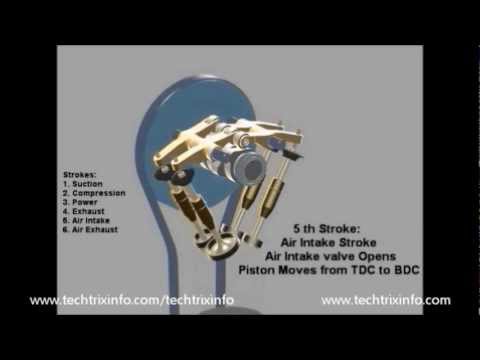One of our regular readers tipped me off to the six-stroke engine and its potential for fuel efficiency and lower emissions. (H/T Brian Templeton.) As you all know, the 4-stroke engine has been around as long as automobiles with refinements but little fundamental change taking place in the engine world. Alternatives such as Wankels and quasi-turbines pop up occasionally but they have never gripped the auto manufacturers.
are a couple of videos explaining the process. You may want to pay attention, the narrator has a heavy Indian accent, but if you don’t get what he’s saying the schematics are pretty self-explanatory.
According to Wikipedia: The term six-stroke engine has been applied to a number of alternative internal combustion engine designs that attempt to improve on traditional two-stroke and four-stroke engines. Claimed advantages may include increased fuel efficiency, reduced mechanical complexity and/or reduced emissions. These engines can be divided into two groups based on the number of pistons that contribute to the six strokes.
In the single-piston designs, the engine captures the heat lost from the four-stroke Otto cycle or Diesel cycle and uses it to drive an additional power and exhaust stroke of the piston in the same cylinder in an attempt to improve fuel-efficiency and/or assist with engine cooling. The pistons in this type of six-stroke engine go up and down three times for each injection of fuel. These designs use either steam or air as the working fluid for the additional power stroke.
The designs in which the six strokes are determined by the interactions between two pistons are more diverse. The pistons may be opposed in a single cylinder or may reside in separate cylinders. Usually one cylinder makes two strokes while the other makes four strokes giving six piston movements per cycle. The second piston may be used to replace the valve mechanism of a conventional engine, which may reduce mechanical complexity and enable an increased compression ratio by eliminating hotspots that would otherwise limit compression. The second piston may also be used to increase the expansion ratio, decoupling it from the compression ratio. Increasing the expansion ratio in this way can increase thermodynamic efficiency in a similar manner to the Miller or Atkinson cycle.
EVEN “COOLER” IDEA
Then, according to Alan Bellows, “a six-stroke design was developed by 75-year-old mechanic and tinkerer called Bruce Crower, a veteran of the racing industry and a the owner of a company which produces high-performance cams and other engine parts. He had long been trying to devise a way to harness the waste heat energy of combustion engines, and one day in 2004 he awoke with an idea which he immediately set to work designing and machining. He modified a single-cylinder engine on his workbench to use the new design, and after fabricating the parts and assembling the powerplant, he poured in some gas and yanked the starter rope. His prototype worked. He estimates that his six-stroke engine could improve a typical engine’s fuel consumption by as much as forty percent.
His addition to the ICE design is simple in principle, yet a stroke of genius. After the exhaust cycles out of the chamber, rather than squirting more fuel and air into the chamber, his design injects ordinary water. Inside the extremely hot chamber, the water immediately turns to steam— expanding to 1600 times its volume— which forces the piston down for a second power stroke. Another exhaust cycle pushes the steam out of the chamber, and then the six-stroke cycle begins again.
Besides providing power, this water injection cycle cools the engine from within, making an engine’s heavy radiator, coolant, and fans obsolete. Despite its lack of a conventional liquid cooling system, his bench engine is only warm to the touch while it is running.”
